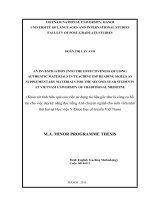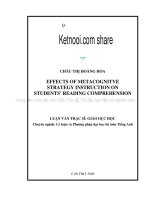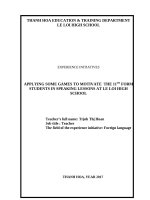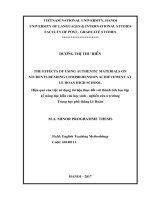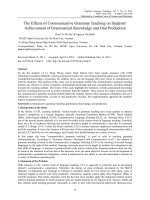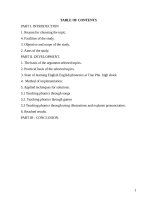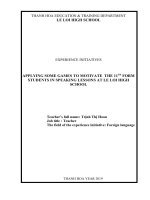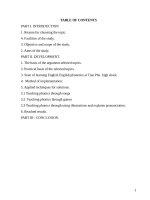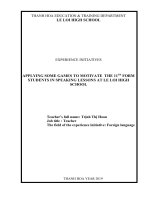THE EFFECTS OF USING AUTHENTIC MATERIALS ON STUDENTS READING COMPREHENSION ACHIEVEMENT AT LE HOAN HIGH SCHOOL
Bạn đang xem bản rút gọn của tài liệu. Xem và tải ngay bản đầy đủ của tài liệu tại đây (1.2 MB, 73 trang )
VIETNAM NATIONAL UNIVERSITY, HANOI
UNIVERSITY OF LANGUAGES & INTERNATIONAL STUDIES
FACULTY OF POST - GRADUATE STUDIES
*********************
DƯƠNG THI ̣THU HIỀN
THE EFFECTS OF USING AUTHENTIC MATERIALS ON
STUDENTS READING COMPREHENSION ACHIEVEMENT AT
LE HOAN HIGH SCHOOL
Hiệu quả của việc sử dụng tài liệu thực đối với thành tích học tập
kỹ năng đọc hiểu của học sinh - nghiên cứu ở trường
Trung ho ̣c phổ thông Lê Hoàn
M.A. MINOR PROGRAMME THESIS
Field: English Teaching Methodology
Code: 60140111
HANOI – 2017
VIETNAM NATIONAL UNIVERSITY, HANOI
UNIVERSITY OF LANGUAGES & INTERNATIONAL STUDIES
FACULTY OF POST - GRADUATE STUDIES
*********************
DƯƠNG THI ̣THU HIỀN
THE EFFECTS OF USING AUTHENTIC MATERIALS ON
STUDENTS READING COMPREHENSION ACHIEVEMENT AT
LE HOAN HIGH SCHOOL
Hiệu quả của việc sử dụng tài liệu thực đối với thành tích học tập
kỹ năng đọc hiểu của học sinh - nghiên cứu ở trường
Trung ho ̣c phổ thông Lê Hoàn
M.A. MINOR PROGRAMME THESIS
Field: English Teaching Methodology
Code: 60140111
Supervisor: Hoàng Thị Xuân Hoa, Ph.D.
HANOI – 2017
DECLARATION
I hereby certify that the thesis “ The effects of using authentic materials
on students reading comprehension achievement at Le Hoan High School”
is submitted for the partial fulfillment of the Degree of Master of Arts at the
Faculty of Post Graduate Studies – University of Languages and International
Studies – Vietnam National University, Hanoi. I also declare that this thesis is
result of my own research and efforts and that it has not been submitted for
any other purposes.
Hanoi, 2017
Signature
Dương Thị Thu Hiền
i
ACKNOWLEDGEMENTS
First and foremost, I would like to show my deep gratitude to all the
lecturers at University of Language and International Studies – Vietnam
National University, Hanoi for the invaluable lecturers, which laid the
foundation for my thesis.
I would also like to express my sincerest gratitude to Dr. Hoang Thi Xuan
Hoa, my respected supervisor for her precious guidance, critical comments
and constructive supervision throughout my research.
My gratitude also goes to the students and colleagues at Le Hoan High
Schools who enthusiastically participated in the research procedure .Without
their help, this project could not be fulfilled.
Last but not least, I am indebted to my beloved family and friends who
have unfailingly inspired me to complete this study.
ii
ABSTRACT
The study was conducted with the hope that the result gained could
clarify the effects of using authentic materials on students reading
comprehension achievement at Le Hoan High School. In order to achieve the
goals, quasi-experimental research design was employed. Subjects of the
study were two groups of 30 students each of 10 th grade – students at Le
Hoan High School. One group was assigned as the experimental group and
the other as the control group. The students of both groups were taught with
the same teaching techniques, the same teaching topics and did the same tests
but with different types of teaching materials in an 8-week-period. While the
experimental group used authentic materials provided by the teacher, the
control group only used materials in the course book - English 10 published
by the Ministry of Education and Training. A pretest and a posttest were used
to measure the improvement in the reading skill of the students in the two
groups.
The research results showed that the reading skill of the students who
worked with authentic materials was better improved than that of the
students working with only course book. The former seemed to be able to
avoid some typical mistakes about vocabulary which the students in control
group often made. Therefore it is suggested that authentic materials be used
in teaching reading skill for high school students in order to get the highest
results. English teachers also need to be creative in selecting, developing and
providing teaching materials to their students.
iii
TABLE OF CONTENTS
DECLARATION ......................................................................................................... i
ACKNOWLEDGEMENTS ........................................................................................ii
ABSTRACT .............................................................................................................. iii
TABLE OF CONTENTS ........................................................................................... iv
LIST OF TABLES ..................................................................................................... vi
LIST OF CHARTS ...................................................................................................vii
PART A: INTRODUCTION .................................................................................... 1
1. Rationale ...............................................................................................................1
2. The research question and objectives of the study ...............................................3
3. The scope of the study ..........................................................................................3
4. Significance of the study ......................................................................................3
5. Methods of the study ............................................................................................4
6. Design of the study ...............................................................................................4
PART B: DEVELOMENT
CHAPTER 1: LITERATURE REVIEW ............................................................... 5
1. Theoretical background ............................................................................... 5
1.1. Overview on reading skill. ................................................................................5
1.1.1. Definition of reading .......................................................................................5
1.1.2. Reading comprehension ..................................................................................6
1.1.3. Reading comprehension achievement ............................................................7
1.1.4. Types of reading comprehension question .....................................................8
1.2. Overview on authentic materials .....................................................................10
1.2.1. Definition of authentic materials ..................................................................10
1.2.2. Types of authentic materials .........................................................................11
1.2.3. Advantages of authentic materials on students reading comprehension
achievement. ...........................................................................................................11
iv
1.2.4. Disadvantages of authentic materials on students reading comprehension
achievement ............................................................................................................14
2. Literature review .................................................................................................16
CHAPTER II: METHODOLOGY ........................................................................ 19
1. Methodology .......................................................................................................19
1.1. The applied methodology in the research. .......................................................19
1.2. Quasi-experimental design...............................................................................19
2. Research design...................................................................................................19
2.1. The subjects of the study..................................................................................20
2.2. Selecting teaching materials ...........................................................................20
2.3. Teaching procedure ..........................................................................................23
2.4. Measuring participants’ competence. ..............................................................24
2.4.1. Data collection instrument ............................................................................24
2.4.2. Procedures of data collection ........................................................................25
2.4.3 Procedure of data analysis .............................................................................26
CHAPTER III: RESULT ANALYSIS AND DISCUSSION ............................... 27
1. Result analysis.....................................................................................................27
1.1. Pretest result analysis .......................................................................................27
1.2. Post-test result analysis ....................................................................................29
1.3. Analysis pre-test and post-test results within each group. ...............................33
2. Discussion ...........................................................................................................35
PART C: CONCLUSION...................................................................................... 37
1. Conclusion ..........................................................................................................37
2. Implications .........................................................................................................38
3. Limitations of the study and suggestions for further research ............................39
REFERENCES ........................................................................................................ 40
APPENDICES ........................................................................................................... I
v
LIST OF TABLES
Table 1: Description of Pre-test Result ......................................................... 28
Table 2: Description of post-test result .......................................................... 30
Table 3: Independent Sample T-test for Post-test result ................................ 32
Table 4: Paired Sample T-test for pre-test and post-test ................................ 33
vi
LIST OF CHARTS
Chart 1: Pretest scores ................................................................................... 27
Chart 2: Post-test results................................................................................. 29
Chart 3: Control group’s results ..................................................................... 34
Chart 4: Experimental group’s results ........................................................... 34
vii
PART A: INTRODUCTION
1. Rationale
The study is based on the current situation of teaching and learning
English reading skill of students at Le Hoan High School. Having been
working as an English teacher at Le Hoan High School for 5 years, the
writer realizes an issue that utilizing only reading materials in the course
books is not enough to help students improve their reading skill. They find
it difficult to learn vocabulary as well as the structures in these texts
because of their unfamiliarity in real life. Therefore, they have low
motivation in learning reading and their reading comprehension cannot
ameliorate over a long time. This fact has been shown clearly in the results
of entrance examinations at high school in the recent years since the form
and structure of English test was changed. Most of students at Le Hoan
High School can not do the reading section well whereas this section takes
account for approximately 50 percentages of the total scores. Therefore the
proportion of the students who get high mark in the exams at Le Hoan High
School is very low. And the only way to increase the number of high marks
is improving students’ reading comprehension competence. Although the
English teachers at Le Hoan School have tried their best to encourage their
students to learn reading skill and improve their achievement by using
different positive teaching techniques, it seems not to bring about much
effectiveness.
Moreover, reading skill is one of the most important skills to each of
students during their foreign language learning procedure. To feature the
importance of reading comprehension, Rivers (1981:147 ) asserted that “
Reading is the most important activity in any language class, not only as a
source of information and a pleasurable activity, but also as a means of
consolidating and extending one's which are knowledge of the language”. In
1
spite of its critical role, reading skill remains a challenge to students.
Taglieber (1988) has indicated three major problems that interfere with
students’ reading comprehension: (1) _ Lack of vocabulary. (2) _ Difficulty
in using language cues to meaning. (3) _ Lack of conceptual knowledge.
That is the reason why the question how to teach reading skill for students to
get the best result is always controversial among the educators. It has been
said that suitable teaching materials play an important role in motivating
students during their learning procedure and help them have certain amount
of background knowledge about different topics which they can meet in
different reading texts. As a result, it can limit the problems that prevent the
students from mastering reading skill well. Implementing authentic materials
in teaching reading skill has taken the concern of many teachers all over the
world. There has been a lot of research debating about this problem since the
1970s; however most of the findings can not be assured to be true to all
learners. Some of the previous studies carried out by Soliman (2013); Akbari
&Razavi (2016); Pandian (2011); Le Thi Huong Giang (2015); Vu Mai
Duyen (2015) mention using authentic materials in teaching and learning a
foreign language, they all confirmed that this type of teaching materials
brought about positive effects. Nevertheless the subjects of all these studies
are college students; the findings needed checking again with the lower-level
subjects. The current research was desired to clarify the effects of authentic
materials on students’ reading comprehension at Le Hoan High School. It
would help the writer to see whether it could have the same results as the
previous research or not. And the findings of the current study would be a
base for the author to decide if authentic materials could be suitable teaching
materials to students at Le Hoan High School
2
2. The research question and objectives of the study
When doing the study, there are a lot of issues which need finding out
and making clear. However, the most important one focused on the current
study is investigating the effects of using authentic materials on students
reading comprehension achievement at Le Hoan High School.
To accomplish the objectives, the research mainly concentrated on
answering the following research question: “What are the effects of using
authentic materials on students’ reading comprehension achievement?”
3. The scope of the study
The study is a small-sized scale thesis, thus it can not cover all the issues
related to the problem discussed. The paper mainly focuses on the effects of
using authentic materials on students reading comprehension achievement at
Le Hoan High School, Thanh Liem district, Ha Nam province. The subjects
in the study are 60 students of 10th grade at Le Hoan High School. They are
randomly chosen and divided into two groups, one experimental group and
one control group.
An important point of the study needs emphasizing that authentic materials
provided to experimental group is only used as a supplementary materials
besides the reading materials taken out from the course book and the reading
activities in class.
4. Significance of the study
The result of the study will be a foundation to help the English teachers
especially the English teachers at Le Hoan High School who are looking for
a new method in teaching reading skill to their students. It supplies not only
a large amount of valuable information about applying authentic materials
but also some suggestions for the teachers in selecting suitable authentic
materials.
3
5. Methods of the study
In order to determine the effects of authentic materials on students
reading comprehension achievement, the researcher utilizes quasiexperimental with sixty 10th grade students at Le Hoan High School. The
pretest and posttest are conducted at the beginning and the end of the
research period. The data collected is analyzed with SPSS.
6. Design of the study
The study consists of three parts
PART A: Introduction provides the rationale, the scope, the research
questions and objectives; the significance and the design of the study.
PART B: Development, discusses the following contents of the study:
Chapter 1: Literature Review, discusses the literature relating reading
skill; reading comprehension; authenticity and authentic materials as well as
the use of authentic materials in teaching English reading skill.
Chapter 2: Methodology, defines the methodology of the research
including features of the participants, settings, research methods, data
collection and data analysis procedure.
Chapter 3: Results, presents and discusses the findings from the data
collected.
PART C: Conclusion, summarizes significant findings, highlights
contributions of the research, addresses notable limitations, and puts forward
practical suggestions for future research.
4
PART B: DEVELOMENT
CHAPTER 1: LITERATURE REVIEW
1. Theoretical background
The study focuses on studying the effects of using authentic materials on
students reading comprehension achievement. Therefore, in the writing
there are some terms used frequently as the key words such as authentic
materials, reading comprehension and reading comprehension achievement.
1.1. Overview on reading skill.
1.1.1. Definition of reading
There are a lot of different definitions of reading activity. Although every
linguistic gives out the definitions by their own words, most of them share
the same idea that reading is a crucial skill in learning procedure and it is
considered as an integral skill to help students to gain information and
expand their background knowledge. When reading, the readers can not just
focus on the meaning of individual word; the most importance of reading is
that they must use the knowledge of linguistics to find out the meaning
hidden behind the printed text. To support the idea Weir (1993) states that
reading is seen as a selective process taking place between the reader and
text, in which background knowledge and various types of language
knowledge interact with information in the text to contribute text
comprehension. Another definition stated by Cooper et al (1988) is that
reading, as one of the language skills to be taught, is a process of
constructing or developing meaning of printed text. In addition, Grabe and
Stoller (2002) suppose that reading is the ability of drawing meaning and
interpreting information in the printed page appropriate. According to
Williams (1989), reading is a process of looking at and understanding what
has been written. Similarly, Goodman (2009) contends that reading is an
essential interaction between language and thought in which the writer
5
encodes his thoughts as language and the reader decodes the language into
thought. Haris and Sipay (1980) considers, reading - (comprehending) as a
result of interaction between the perception of graphic symbols that
represent language and the readers’ language skill and knowledge of the
world.
In short, the term reading can be defined in many different ways with a
certain difference in the opinion of the linguists. However, most of them
agree that a successful reading process must draw out the message behind
the words used by the writer. Thus, reading is an interaction between the
readers and the writers.
1.1.2. Reading comprehension
From the definitions of reading activity, the linguists also discuss
reading comprehension. According to Rubin (1993) reading comprehension
is a complex intellectual process involving a number of abilities. It means
that reading comprehension is not simple; it asks the readers to use the
different abilities to overcome the difficulties in finding unstated clues and
implied meaning. For this reason, each reader may have a different level of
reading comprehension. The factors such as age, motivation, awareness, and
life experience or background knowledge can affect the outcome of reading
comprehension. Sharing the same idea with Rubin, Johnson et al., (2004)
say that reading comprehension is an active process, directed by intentional
thinking that allows young readers to make connections between their
thinking processes, the textual content, and their own knowledge,
expectations, and purposes for reading. The students’ comprehension ability
will guide them to understand the text, they will get the information, whether
the information is clearly stated or implicitly stated.
In a nutshell, reading comprehension is the ability of the readers in
understanding the meaning of a text. By gathering the information stated in
6
the text with their background knowledge and some sub-reading skills, the
students can draw out the implied message. As stated by Suparman (2012)
the sub-reading skills that a reader should master to deeply understand the
text; for instance, identifying main idea, identifying details, understanding
vocabulary, making inference and making reference are really important to
students’ improvement.
1.1.3. Reading comprehension achievement
After finishing a reading course, reading comprehension achievement of
students is what a teacher expects most. To know whether or not the
students make progress, an achievement test may be conducted. As Grellet
(1996) says reading comprehension achievement can be defined as the
successful result of students’ comprehension in guessing, predicting, and
understanding the written text by doing such an achievement test. The test
is a tool to assess learning procedure of learners. Therefore, reading
comprehension achievement is expected to be good to fulfill individual
improvement in academic performance.
In addition, another linguist Mc Whorter (1989) supposes that reading
comprehension
achievement
covers
some
aspects
such
as
word
comprehension, sentence comprehension, paragraph comprehension and
text comprehension.
As appreciated by many scholars, an individual may comprehend a text
fully when he can:
1.
Recognize the words and sentences of the text and know what these
words and sentences mean (obtain literal meaning)
2.
Associated meanings, both denotative and connotative from personal
experiences with the printed text (obtain inferential meaning)
3.
Recognize how all these meanings and/or his perceptions of them fit
together contextually.
7
4.
Make value judgments about, and based on the reading experience
(read critically)
It means that a good achievement test must inspect students’
comprehension about all aspects above.
1.1.4. Types of reading comprehension question
There are a number of reading comprehension question types that the test
takers often have to deal with in the reading section. To overcome these
types of questions well, the examinees need to recognize the question types
quickly, and understand the aim of the questions as well as the common
traits of correct and incorrect answers. According to Peterson’s (2000) and
the forms of the questions often appearing in the test, the test takers often
meet the main types of questions as follows.
Main idea.
The main idea question requests the test taker to make out what the
passage or the paragraph is discussing about. It is often found in the topic
sentence which is at the beginning or at the ending of the passage. It includes
a topic and a something about the topic. Thus, the test taker must be able to
identify the thesis of the passage and those ideas that support this thesis.
Supporting idea
Supporting idea question, in fact, is the question about the specific
information stated in the passage. It often begins with “according to the
passage” or “the passage states that”. The answer to the question is
contained in two or three sentences. If the test taker has a better ability to
find a specific piece of information, he will be able to find the answer more
easily.
Inference
8
Inference question is said to be one of the most difficult questions in the
reading section because it does not ask directly stated information in the
passage. Actually, the candidates must make conclusion based on the
directly stated information. Most these questions are often prefaced by "the
passage implies" or "the author implies", where "suggests" is sometimes
substituted.
Tone & Style
The tone question is the one which refers to the predominant emotion or
absence of it displayed by the author. Answering this type of question is that
the examinee must specify the attitude of the author toward the subject or the
character in the passage. Naturally, the tone can be classified as subjective or
objective. If the author has an objective attitude, he will not choose any side.
On the contrary, his attitude will be subjective.
Passage Structure
Passage structure is the way the author arranges the supporting ideas in
the paragraph. Any arrangement of the ideas also reflects the author’s
purpose when writing the paragraph. Thus, the key to this type of question is
the relationship between the ideas with the passage. Only when the test
takers understand this, they can find out the logical order.
Reference question
Reference question is considered one of the easiest question types. It
requires the examinees to determine what a noun, a noun phrase, a pronoun
or an expression refers to. Normally, it is used to replace another noun
preceding it; however, the answer is not always the noun or the expression
which is closest to it.
Vocabulary-in-context question
9
Vocabulary-in-context question is the one that asks the candidate to
make out the suitable meaning of a specific word in the passage based on the
context. A single word may have more than a meaning, but only the most
suitable one can be used in the paragraph.
1.2. Overview on authentic materials
1.2.1. Definition of authentic materials
Any teacher who would like to improve their students’ comprehension
achievement, he needs to motivate them during the learning procedure by
using suitable teaching materials. Only when being taught by the materials
they are interested in, can the students gain a good achievement. On finding
materials that meets the teachers and students’ needs, most of the researchers
started concerning the term “authentic materials” and agreed that authentic
materials should be brought into classes. Defined by Nunan (1989); “any
material which has not been specifically produced for the purpose of
language teaching.” (Cited in Macdonald, Badger &White, 2000). Similarly,
Wong (1995) defines authentic materials as the materials which are used in
genuine communication in the real world and it is not specifically prepared
for the teaching and learning of English. Except for these two scholars, there
are some other ones sharing this point of view such as Nunan (1988), Jordan
(1997) and Herod (2002). Besides, to make the definition of authentic
materials more clearly by supporting some examples, Grellet (1996) gives
out his own definition that authenticity is no change of the original text and
its presentation and lay out are retained. A newspaper article, for instance,
should be presented as it first appeared in the paper with the same typeface,
space devoted to the headlines, and pictures.
Thus, authentic materials can be understood simply that it is a kind of
materials which is used in our daily life to solve real social situations. They
are not redesigned for language teaching purposes.
10
1.2.2. Types of authentic materials
As mentioned above, source of authentic materials is very plentiful
because it can be anything that supports for our life. They are not only
newspapers, magazines but also songs, web pages, radio, TV broadcasts,
films, leaflets, flyers, posters. They are both in written form and spoken
form. In fact, it depends on the topic, the purpose of the lesson and the
interest of the learners, the teacher can find and choose the suitable type and
form of authentic materials to bring into classes. Although there are so many
types of authentic materials listed. According to Genhard (1996), they can be
classified into three categories including:
1. Authentic printed materials, such as sports reports, newspapers, restaurant
menus, train tickets, etc.
2. Authentic listening materials, such as radio news, cartoons, songs, etc.
3. Authentic visual materials, such as street signs, magazines and
newspapers pictures, post cards, etc.
1.2.3. Advantages of authentic materials on students reading
comprehension achievement.
As mentioned above, applying authentic materials on learners reading
comprehension achievement has been taken into account in numerous
studies. In these studies, the effectiveness of using authentic materials in
teaching reading skill has been confirmed. Many researchers who approve of
using authentic materials to teach a foreign language emphasize the
usefulness of authentic materials. They suppose that it is the way of
employing formulaic teaching materials from text books written with
classroom dialogue practices that are artificial, thus presenting a gap from
real life language among language teachers, which destroys students’
motivation in learning language, whereas motivation is considered as a key
factor helping them involve in mastering a foreign language. To change the
11
situation, they also express that replacing the traditional materials by
authentic materials which were written for native speakers of certain
communication and will be used by the speakers of the language in
communication circumstances outside of the classroom. Some famous
researchers support for this ideas such as Guariento and Morley, 2001;
Paltridge, 2001; Shrum and Glisan, 2000. Most of them agree that this kind
of materials increase the learners’ motivation toward reading. Especially,
Otte, 2006 and Thanajaro, 2000 clearly showed that after utilizing authentic
materials in language classroom, the improvement of learners’ selfsatisfaction and motivation go up remarkably. In addition to, Guariento
&Morely, 2001 say that authentic materials help motivate learners learn the
language by making them feel that they are learning the 'real' language. And
Hyland (2003) states that one of the most important advantages of using
authentic materials is that it increases learners’ motivation and reflect
positively on the learning process. Explaining the reason why authentic
materials is often more highly appreciated than text books Speller (2002)
and Rizgiyah (2009) say that authentic materials can be up to date and
related to the everyday issues and activities. The use of authentic materials
in the classroom can motivate the students because there are three layers of
learning that are: language learning (the structure and vocabulary), cultural
insight, and practical application. In fact, the teachers can explore an
abundant source of authentic materials from real life such as magazines,
newspapers, street signs, etc. According to Genhard (1996), there are three
types of authentic materials that the educators can choose to make it suitable
with the purpose of each lesson. The first type is authentic listening
materials such as radio news, cartoons, songs,…The second one is authentic
visual materials such as street signs, magazines and newspapers pictures,
postcards… and the last one is authentic printed materials such as sport
12
reports, newspapers, restaurant menus, train tickets, etc. Therefore, when
teachers use authentic materials as teaching aid in language classroom, they
not only teach their students a basic language skill but also build a
foundation of social knowledge for the learners. They easily find out a
relationship between the knowledge and skills learnt at school and the real
life. In general, most of the researchers share the same point of the
usefulness of authentic materials. Peacock (1997) says that there are some
advantages of using authentic materials in the classroom, they are: original,
interesting, motivating and useful. Garcia (1991) claims that using authentic
reading materials help to improve the learners' cultural awareness. Sherman
(2003), mentions that the importance of authentic material reside in the fact
that "it is a window into culture”. Kilickaya (2004) states that using
authentic materials helps to increase learners' motivation for learning a
language, because they feel that they are practicing a real language used
beyond the classroom. In addition, Thanajaro (2000) and Otte (2006)
concluded in their studies that authentic materials have a positive effect on
learners' motivation and encourage them to learn better. When talking about
the effectiveness of this teaching aid in developing students reading
comprehension, Harmer (1994) points out some benefits such as helping
learners produce better language; helping learners acquire the language
faster and making learners more confident to deal with real life situations.
Finally, Berardo (2006) having experienced using authentic materials,
notices that they contributed in increasing his learners' motivation and he
himself, likes using them. From two experiments conducted by Lestari
(2007) and Pramediastuti (2007), the results recorded showed that the
students’ reading comprehension achievement after teacher applied authentic
materials in teaching is considerable. Lestari (2007) found that authentic
materials can improve the students reading comprehension achievement
13
from 59.47% in cycle 1 to 78.37% in cycle 2. In a word, lots f scholars have
the same ideas about the advantages of authentic materials in foreign
language classroom and the findings of their studies done are also suitable
with their point of views.
1.2.4. Disadvantages of authentic materials on students reading
comprehension achievement
Although authentic materials are considered as a good source of language
teaching materials, they also bring about some disadvantages. Some other
researchers state their ideas about the drawback of authentic materials. The
first point they point out is the difficulties of vocabulary as well as structures
used in daily objects such as newspapers; magazines or streets signs. In these
materials, a large number of words are written in abbreviation form, many
words are slang which is used in certain communication. Thus authentic
materials cannot be appropriate for students, especially weak students who
will feel tired of these materials if they do not understand even the words
appearing in the text assigned by the teachers. A scholar, Kilickaya (2004),
claims that authentic materials add a burden on teachers, as they may contain
difficult vocabulary and structures which need more effort to be simplified
and explained, in order to make them appropriate for their learners. The
second point mentioned in some research studies is the difficult content of
the authentic texts. They argue that most of the authentic materials which are
not easy for the language learners to follow their content because they
contain the socio-cultural problems and they are far from students’
background knowledge. Another scholar Martinez (2002) says that authentic
materials are regarded too culturally biased and difficult to comprehend by
learners in the classroom. Besides, he also discusses the issue related to the
cultural effect, that “authentic texts from one culture may give a false
impression to students from another, unless they are presented in an
14
authentic context which makes it clear precisely what they exemplify”. For
this reason, if a language teacher still wants to employ an authentic material
in his lecture, he has to select the materials carefully to ensure that they are
suitable with their students’ competence. Additionally, when making lesson
plan the teacher needs to forecast the difficulties that students may meet
during the learning process, for instance the difficult words ; the complex
structures. However, this job can take the teachers a lot of time. Miller
(2005) states that authentic materials are “too difficult and time consuming
to select, edit and prepare”. Furthermore, some researchers also mention
other problems of using authentic materials such as its real effectiveness on
students’ improvement on reading comprehension. Mihwa (1994) found that
the level of reading comprehension of weak ESL learners was not affected
by the text, regardless of its type, authentic or non-authentic. In addition,
Kienbaum et al. (1986) state that there are no significant differences in
learners' performance: between learners using authentic materials and others
who use traditional materials. To weak students, authentic materials are
considered as a bad tool in teaching reading skill. Kilickaya (2004) believes
that using authentic materials with weak learners frustrate and de-motivate
them, because they lack the required skills and vocabulary to deal with
presented text, successfully. Guariento and Morley (2001) assert “At lower
levels…the use of authentic texts may not only prevent learners from
responding in meaningful ways, but can also lead them to feel frustrated,
confused and… de-motivated”. In a nutshell, there are still two tendencies
coexisting, one supports for using authentic materials and one objects, but
obviously the advantages outweigh the disadvantages so the teacher should
consider the teaching materials to limit the drawbacks and intensify the
benefits of this kind of texts.
15
In the current research, the reliability of the study would be confirmed by
doing experiment on lower-level students at Le Hoan High School in
comparison with the previous ones conducted on college students. The study
was also done in a longer period of time. With the findings of the study,
English teachers would find it valuable to apply authentic materials in
teaching reading skill to their students. Besides, the author would give out
some implications and suggestions for further study.
2. Literature review
As mentioned above, authentic material has been the subject of a lot of
science research. The authors of these studies tried to investigate its effects
on foreign language acquisition of students. Most of the findings of these
investigations demonstrated the advantages of authentic material in language
lessons. Students’ results were also improved after working with this
teaching material not only with reading skill but also with other language
skills such as speaking, listening and writing. In a research carried by
Soliman (2013), he said that the learners get not only many significant
advantages from using authentic materials but also higher level of
motivation as well as interest in language learning.
Khoirul Farari Marwan (2013) conducted a research to check the
improvement of students’ English reading comprehension through authentic
materials. To achieve the aim of the study, he used an action research. The
study only focused on a particular problem and a particular group
of
students
implementing
problems
in
a
certain classroom. It
the research,
the
researcher
means
needs
that
before
to identify
any
really found in the classroom.
There are some steps in the research including reconnaissance, planning,
implementing and observing, and reflecting. In the first step, problems were
determined by conducting observations and interviews. The researcher
16

